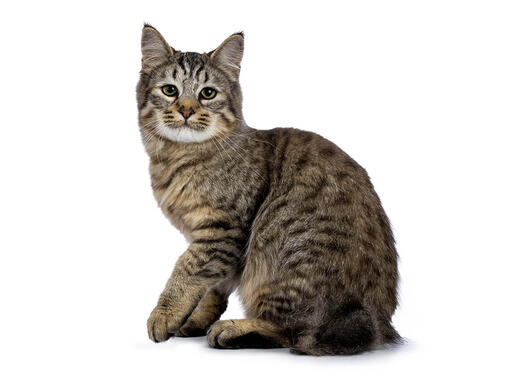Cat Breed - Pixiebob

About the Pixiebob
Introduction: Pixiebob - A Comprehensive Guide
Brief Overview:
The Pixiebob is a rugged, wild-looking domestic cat breed known for its bobbed tail, muscular build, and a demeanor that’s often described as dog-like. Despite their exotic appearance—resembling the North American bobcat—Pixiebobs are 100% domestic, affectionate, and make devoted family companions. They are also one of the few cat breeds that may naturally have polydactyl (extra-toed) paws, a trait accepted by breed standards.
Breed History
Origins:
The Pixiebob breed began in the Pacific Northwest of the United States in the 1980s, when breeder Carol Ann Brewer rescued a short-tailed male cat with a bobcat-like look. She later acquired a similar female and began a breeding program to preserve their wild appearance and gentle personality.
The breed was named after “Pixie,” one of the first kittens produced in the program. Although early Pixiebobs were believed to be part bobcat, DNA testing confirms they are fully domestic cats with no wild lineage.
Pixiebobs were officially recognized by The International Cat Association (TICA) in 1995 and remain a rare but admired breed.
Physical Characteristics
Pixiebobs are medium to large cats with a muscular, athletic build and a distinctively short tail. Their wildcat look is one of their most defining features.
Body:
Medium to large, muscular, and substantial
Heavy boning with a rectangular body shape
Males weigh 12–17 lbs, females typically 8–12 lbs
Coat:
Available in both short and longhair varieties
Dense, soft double coat, often weather-resistant
Accepted coat colors: brown spotted tabby only (no other colors permitted in breed standard)
Spots are random and may form rosettes or linear streaks
Head & Face:
Pear-shaped head with a broad, prominent muzzle
Heavy brow and hooded eyes give a “serious” or wild look
Lynx-tipped ears may appear slightly rounded
Eyes:
Medium-sized and deeply set
Eye color ranges from gold to green, with gooseberry green preferred
Legs & Paws:
Strong, long hind legs
Polydactylism is allowed and common, with up to seven toes per paw
Large, wide paws help create their bobcat-like appearance
Tail:
Typically 1–6 inches long
Can be kinked or knotted but is always expressive and mobile
Personality and Temperament
General Disposition:
The Pixiebob is beloved for its loyal, calm, and affectionate temperament. They are often compared to dogs for their bonding behavior and trainability.
Highly Social: Bond deeply with their families and enjoy being involved in daily routines
Dog-Like Traits: Many Pixiebobs play fetch, walk on leashes, and follow their humans around
Gentle and Patient: Excellent with children and other pets
Intelligent and Curious: Enjoy puzzle toys, interactive games, and learning tricks
Moderately Vocal: Communicate through chirps, trills, and soft meows rather than loud cries
They thrive in homes where they receive daily attention, affection, and mental stimulation.
Health and Lifespan
Pixiebobs are generally healthy and hardy, with a life expectancy of 13–16 years or more. Because they are a naturally occurring breed with wide genetic diversity, they are less prone to many hereditary issues.
Common Health Considerations:
Hypertrophic cardiomyopathy (HCM)—rare but should be screened for
Cryptorchidism (undescended testicles) in males has occurred in some lines
Dystocia (difficult birth) in females, due to wide skulls in kittens
Polydactyl cats may need extra nail care and monitoring of toe alignment
Grooming Needs:
Shorthair Pixiebobs: Brush once a week to remove loose hair
Longhair Pixiebobs: Brush 2–3 times a week to prevent tangles
Routine nail trims, including for extra toes
Clean ears and brush teeth regularly
Diet and Nutrition:
High-protein, balanced diet appropriate for a large, muscular breed
Watch portions to prevent weight gain
Provide fresh water at all times
Exercise and Play:
Daily playtime is essential—these cats love movement
Puzzle toys, interactive games, and fetch sessions are favorites
Enjoy leash walks and outdoor time in secure areas
Breed Standards
The International Cat Association (TICA) recognizes the Pixiebob in both shorthair and longhair varieties, with allowances for polydactylism.
Specific Standards for Pixiebob Cats (TICA):
Body: Medium to large, muscular, and rectangular
Coat: Dense and soft; short or semi-long, only brown spotted tabby
Head: Pear-shaped with prominent muzzle and brow
Eyes: Deep-set, medium-sized, gold to green
Legs & Paws: Long hind legs, large paws; polydactyl allowed
Tail: 1–6 inches long, flexible, and expressive
Other Features: Wild appearance with a soft, domestic temperament
View official breed standards at:
Interesting Facts
Interesting Facts About the Pixiebob
Polydactyl Friendly: One of the few breeds where extra toes are part of the breed standard
Bobcat Myth: Though they look wild, Pixiebobs have no actual bobcat DNA
Natural Breed: Their appearance was not designed in a lab—it evolved naturally in the Pacific Northwest
Tail Talkers: Their expressive bobbed tails help convey their emotions like a waving flag
Strong Climbers: Despite their size, Pixiebobs are agile and love vertical spaces

